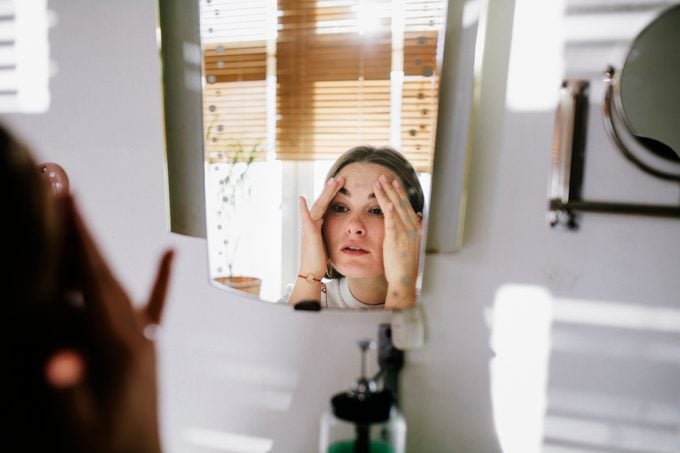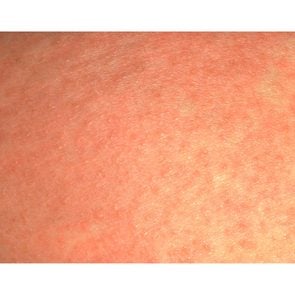Why Is My Face Red? 11 Conditions That Can Cause a Red Face
Updated: Oct. 20, 2020
If you feel like your face is always flushed, red, or rosy, one of these conditions could be the reason why.
What causes facial flushing?
Whether it’s from embarrassment or exercise, too much sun or too much alcohol, most of us have experienced an instance of going red in the face. And it’s usually pretty easy to figure out why our skin has taken on a ruddy glow.
But some people are prone to more lasting periods of redness—or redness that comes and goes, but seems to increase in frequency. If that’s the case, there might be something going on beneath the surface. If you have persistent redness, it’s best to see a dermatologist or your general practitioner to figure out what’s happening.
“Facial redness can be caused by various conditions, and the underlying issue involves inflammation,” says Lisa Anthony, MD, a dermatologist at Westmed Medical Group in Westchester, New York. “A thorough review of a patient’s history and physical exam can clue me in to what is the cause of facial redness.”
Here are some of the common conditions your doctor might consider. (Keep in mind that there are additional reasons you can have facial redness, including skin infections, acne, wind burn, reactions to medications, and conditions like lupus, which can cause a butterfly-shaped rash on your nose and cheeks. Only your doctor can say for sure.)

Blushing
Feeling the blood rushing into your face is a sensation most of us have experienced. But why?
“Blushing and flushing are innately patterned, emotional responses that may occur when we experience shame, humiliation, embarrassment, sexual excitement, or social threat,” says Mary C. Lamia, PhD, a psychologist in Kentfield, California. “In such situations, our glands release the hormone adrenaline, which has an effect on our nervous system. That, in turn, causes the capillaries that carry blood to our skin to widen. Since blood is brought closer to the surface of the skin, it causes a blush or flush.”
This typically occurs in the face, neck, or upper chest; it’s more pronounced with flushing, which can occur when angry. As in the expression “blushing bride,” the phenomenon can even signal romantic interest in another person.
Blushing is more noticeable in those with fair skin, and for some people, it can happen so often that it affects their quality of life. If you’re tired of blushing all the time, it may be time to see a doctor to figure out if there’s something else triggering your ruddy glow, or if psychological techniques can help you prevent your body’s response.
Contact dermatitis
This is the fancy name for an allergy, irritation, or reaction to something that touches your skin. It shows up as “rashes that occur when the skin becomes irritated or allergic to compounds in personal-care products or environmental exposures,” says dermatologist Jason A. Clark, MD, adjunct assistant professor of dermatology at Emory University in Atlanta. Makeup, creams, and fragrances are all potential culprits.
With an allergic reaction, you might notice redness, itching, scaly skin, bumps, or blisters, says Shaan Waqar, MD, an allergist and immunologist at ENT & Allergy Associates in Somerset, New Jersey. “Allergic contact dermatitis is caused by a delayed reaction to a contact allergen.”
You can even develop this reaction after years of using a product, he adds. People “can become sensitized to a chemical over time, after which exposure to the chemical triggers an immune reaction in your skin.”
In order to figure out exactly what allergen is triggering the response, “patch testing can be performed at an allergist’s office to identify the specific contact allergens, and guide allergen avoidance,” Dr. Waqar says. You might also be prescribed a short-term topical steroid to help clear up your current rash.
Rosacea
This inflammatory skin condition can show up in a variety of ways. Rosacea symptoms may include “red bumps or pimples, a ruddy complexion from fine, broken capillaries concentrated in the ‘T-zone,’ and dynamic flushing,” says Dr. Clark. Although rosacea is poorly understood, “we know that genetic and environmental factors play a role.”
With rosacea, blood vessels are overreactive, and the skin is often hyper-irritable, as well. Triggers—such as spicy foods, hormonal fluctuations, or changes in temperature or emotion—can bring on symptoms.
“Facial redness from rosacea may result from different factors,” says Dr. Anthony. “There may be abnormal immune signals, inflammatory reactions to skin microbes, sun ultraviolet damage, and hyper-reactivity of blood vessels. Various treatments target each of these potential mechanisms.” These include topical and oral prescription meds, as well as laser treatments that target visible blood vessels.
Seborrheic dermatitis
This type of skin irritation is known as dandruff (or cradle cap for babies) when it’s on the scalp. But it can also appear on the face.
“It’s an overgrowth of a yeast that’s on all of our bodies naturally,” says Mona Gohara, MD, a dermatologist in Connecticut and associate clinical professor in the department of dermatology at Yale School of Medicine. “You can get flaky, red skin on the face” that can look a lot like rosacea.
It’s not clear why some people get this inflammatory condition. “One theory is the body becomes increasingly reactive to yeast flora with age,” Dr. Clark says. It appears as “redness and flaking at the eyebrow, ears, and folds of the cheeks. The flaking and redness can be most apparent in hair-bearing areas of the scalp, beard, and also areas with high concentration of oil glands such as the ears.”
Dandruff shampoo can help your scalp; washing your face with a product containing similar ingredients, such as zinc pyrithione, can help as well. You can also try these natural treatments.
Perioral dermatitis
This type of dermatitis may cause a red facial rash that could be mistaken for other skin conditions. “Perioral dermatitis can look almost exactly like rosacea, and they’re treated similarly,” Dr. Gohara says. It can also look like acne, appearing around the mouth, or possibly the nose and eyes. A trained dermatologist can help correctly identify it.
The cause isn’t clear, but perioral dermatitis could be a type of allergy or irritation that’s often linked to an overuse of over-the-counter steroid or hydrocortisone creams, according to the American Academy of Dermatology.
If you’ve been using a steroid cream on your face for a while, it may actually be worsening your condition. Stop applying it and see your doctor, who may prescribe an antibiotic to calm the inflammation. A gentle skin care routine can also help.
Spider veins
Redness from tiny capillaries can show up as something commonly called spider veins. “Spider veins are visible thin red lines, and are broken blood vessels,” Dr. Anthony says. “It can be related to rosacea as well as sun damage, genetics, pregnancy, and myriad other conditions.” All of these can make blood vessels dilate and expand.
Spider veins can also be linked to aging and certain medications, and commonly appear in the T-zone of the face, says Dr. Clark. In the United States, spider veins have a “propensity for the left [side of the] face, from sun exposure during driving,” he says. “We treat them with lasers that target the hemoglobin, a component of red blood cells traveling through these vessels.”
To help reduce your risk of spider veins, use sunscreen on your face to avoid sun damage.
Atopic dermatitis
Better known as eczema, this itchy, chronic skin rash is common: One in 10 Americans has it, according to the American Academy of Dermatology. Although it’s more prevalent in children, it can also be a lifelong condition that affects adults, as well.
“In atopic dermatitis, inflammation results from an innate dysfunction of the immune system,” Dr. Anthony says. This inflammation leads to red, dry, irritated, and itchy skin that can appear on the face and even around the eyes.
There may be a genetic cause for eczema, which can often flare up due to triggers from the environment, such as soap or pollen. To help calm eczema, keep skin hydrated and moisturized, avoid your triggers, and apply dermatologist-prescribed creams and ointments.
Menopause
For women around the age of 50 (or earlier or later, depending on genetics and certain health conditions), a sudden onset of flushing could be due to hormonal changes resulting from menopause.
The same hot flashes that spread throughout the body, “may also make the face and neck flushed,” says Jen Caudle, DO, a family physician and associate professor at Rowan University School of Osteopathic Medicine in Glassboro, New Jersey. “This flushing is likely due to increased blood flow to the areas.”
Although doctors don’t know exactly why this happens, they think it may have to do with how hormone changes affect your body’s ability to regulate its temperature.
In any case, there are home remedies for hot flashes that can help. Dress in layers you can remove when a hot flash comes on; you can even carry a tiny portable fan. Alcohol, spicy food, and caffeine may make hot flashes worse, so you might want to avoid them. Calming techniques like yoga or relaxation breathing may help as well. If these home remedies don’t work, talk to your doctor about medications. Hormone treatment may be available, but a low-dose antidepressant may also be effective.
Shingles
If you have a red rash on one side of your face, it could be shingles, also called herpes zoster.
“Shingles may start out as a painful, red bumpy rash,” says Dr. Anthony. “Over time, blisters develop that eventually crust over. The redness is inflammation in the skin caused by reactivation of the chickenpox virus.”
This reactivation could happen if your immune system is weakened. Because shingles most often affects older adults, it’s recommended to get the shingles vaccine to prevent it from developing in the first place.
If you think you might have shingles on your face, see a doctor right away for antiviral medications, as the disease can lead to vision loss if it’s near your eye or hearing loss if near your ear.
In addition, “the infection itself results in red blisters that become crusted scabs, and ultimately leave red or brown marks as well as textured scars that may remain painful for years,” Dr. Clark says. “See a board-certified dermatologist, and treat it early to prevent scarring and risk for long-term pain.”
Psoriasis
As with other puzzling skin conditions, psoriasis likely occurs in some people due to a combination of genetic factors and environmental causes, such as stress or skin injury, that trigger it.
With psoriasis, immune system problems lead to inflammation and rapid development of skin cells, which build up quickly and lead to red, scaly patches.
According to the National Psoriasis Foundation, 50 percent of people with psoriasis have it on their face, most typically along the eyebrows, the skin between the nose and upper lip, the upper forehead, and the hairline.
If you are diagnosed with psoriasis on your face, you’ll want to use gentle, non-irritating skin products that your doctor can recommend. You’ll likely also be treated with prescription medications, either oral or topical. Light therapy may also slow the growth of skin cells. In addition, these foods could make psoriasis worse.
Thyroid disease
A dermatologist may be the first to spot some problems that seem unrelated to the skin. Case in point: The thyroid gland in your neck can be overactive or under-active, and the incorrect level of thyroid hormone can cause skin changes.
Having too much thyroid hormone (hyperthyroidism) can cause increased blood flow, leading to warmth and redness in the face. Your dermatologist may check for other symptoms in order to determine if the redness is a result of thyroid disease. (Here’s the difference between hyperthyroidism vs. hypothyroidism.)
“Facial flushing with palpitations and increased sweating points to a hyperactive thyroid issue,” Dr. Anthony says. You’ll need to see an endocrinologist for treatment, including medications to lower the amount of thyroid hormone in your body.





















